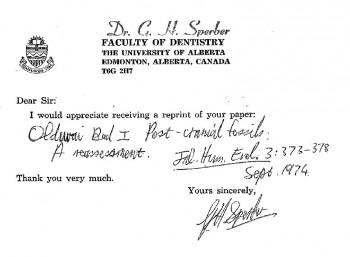I spent most of the day yesterday ‘fall cleaning’ my office, and in doing so I recovered/uncovered some old ‘reprints’ of papers of mine, a copy of Current Contents, sheets of Letraset, a Rotring pen, and some stencils.
For those brought up in the era of pdfs, reprints (also called offprints or separates) were the only way an article could be disseminated independently of the reader having access to a copy of the journal in their university library. Reprint collections were, and in my case still are, a personal library. In the days of yore when your proofs came there was nearly always a ‘reprint request form’. A few journals gave you some (c.50) free reprints, but most charged you quite steeply for them. The usual way to request reprints was to send a short note (Clark Howell did this assiduously), or a formal ‘reprint request’. This took the form of a postcard that allowed you to fill in the name of the article and the author. The sophisticated ones had the return address on the back so the card could be pasted to the front of the envelope used to send the reprint. As you may have guessed, reprint requests were a crude form of citation index. No reprint requests in your mailbox meant little or no interest in your paper!
Current Contents was the initiative of Eugene Garfield who founded the Institute for Scientific Information. Each edition of Current Contents consisted of reproductions of the title pages of recent issues of journals printed on very thin paper so that copies could be sent airmail to subscribers. There was also an author index plus the address of the lead author. Current Contents saved you going up and down the racks of current journal issues to look at the title pages; they were all conveniently collected together for you. It also provided the address of the first author, so you could use this to request reprints. The first Current Contents covered biology and medicine, but gradually this subscription service was extended to other subjects.
Letraset was a UK company that made sheets of dry transferrable lettering; they also made sheets that had symbols like stars, circles and arrows. The sheets of lettering used to have all the letters of the alphabet, but even though there were more copies of vowels than consonants, you always seemed to end up of with sheets with no more vowels, but lots of ‘Ks’ and ‘Js’, or if you were a paleoanthropologist you soon exhausted the ‘As’ and ‘Hs’. Armed with the Rotring pen you made yourself a graph and then you used the stencils or Letraset to label the axes. You plotted the data points on the graph in pencil and then you used Letraset circles, squares or stars to identify the different samples. The trick with Letraset was to apply even pressure over the symbol with a coin, or with a blunt wooden tool. Then you had to carefully peel the sheet away, hopefully leaving your chosen symbol intact on the graph. But if the Letraset sheets were old the letters were fragile and brittle, so you ended up with most of your letter on the graph and some still on the Letraset sheet. As you might imagine Letraset could be both a boon and a bane.
All this frustration could be avoided if your department or institution had a scientific illustrator whose job it was to make scruffy draft figures into works of art. But in my experience only the senior academics had access to the scientific illustration service (departments were billed by the hour), so if you were starting out, you took yourself off to the art shop and then braced yourself for many hours of silent (or in my case, not so silent) cursing and swearing.
So if you ever look at a paper from before the days of readily accessible software for making figures, and personal computers (there was only one computer in the University of London when I did my PhD thesis), please don’t be too hard on the amateur ‘artwork’.


